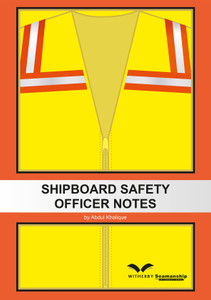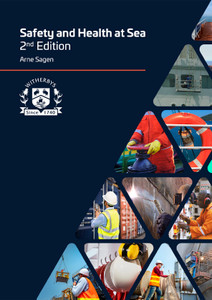
Marine Survival is a study aid for cadets and ships' officers. Now in its third edition, topics covered include evacuation systems, onboard training, helicopter operations, personal survival, emergency communication and medical advice, as well as a new section on lifeboat release hooks and FPDs, which incorporates the latest SOLAS and IMO amendments applicable to life saving appliances.
Marine Survival provides detailed guidance on topics such as emergency and distress communications, evacuation systems, life saving equipment, emergency alarms and onboard training, helicopter operations and recovery systems.
This new edition has been fully updated to incorporate the advances in marine survival operations since the last edition was published over twenty years ago. It includes a new section on lifeboat release hooks and FPDs (including details of new SOLAS and IMO amendments on life saving appliances) and updated information on helicopter activity, rescue boat operations, emergency communications and medical advice.
Since the publication of the two previous editions of ‘Marine Survival & Rescue Systems’, in 1988 and 1997, major changes to life saving appliances have taken place, not least the requirements for immersion suits for marine personnel but also new ideas towards vertical chute evacuation systems. Improved release systems for survival craft with the recommended addition of fall preventative devices. Such changes being made with the view to reducing the number of accidents which have previously occurred with survival craft operations.
The revised text has incorporated the latest SOLAS and IMO amendments applicable to the Life Saving Appliances (LSA code 2003) applicable to ships registered in the United Kingdom, where ever they may be and other ships while in United Kingdom territorial waters.
This latest edition provides a more informed presentation on helicopter activity and rescue boat operations, hopefully, providing the reader with a greater understanding of these influential aspects of the industry. Up to date content on communication systems effecting the maritime environment together with medical advice on the treatment of marine casualties.
The more recent incidents of the loss of the ‘Riverdance’ and the Offshore Oil drilling rig ‘Deepwater Horizon’ in the Gulf of Mexico, show only too well the many dangers associated with the marine environment. Bad weather, human error, lack of equipment knowledge, complacency are just a few of the elements that frequently effect maritime operations.
Throughout the text the need for continuous training both ashore and afloat is emphasized. It is virtually impossible to gain reality disaster experience unless an actual emergency has taken place, and the individual has survived the incident. It is hoped that this book will go some way to prepare our mariners, who one day may be faced with that reality situation.
Acknowledgements
Authors Introduction
1 Evacuation Systems and Marine Requirements
1.1 Introduction
1.2 Actions Before Abandoning Ship or Offshore Installation
1.3 Survival Craft: Manning Requirements Applicable to all Ships
1.4 Responsibilities of Coxswains when Abandoning Ship or Installation
1.5 Methods of Evacuation
1.6 Survival Actions in the Water
1.7 Actions in Survival Craft (of the totally enclosed type)
1.8 Main Dangers to Survivors
1.9 Summary
2 Immersion Suits, Lifejackets and Buoyancy Aids
2.1 Introduction
2.2 Requirements for the Provision of Immersion Suits and Thermal Protective Aids on Ships
2.3 General Requirements for Immersion Suits
2.4
Requirements
for
Thermal
Protective
Aids
(not
to
be
confused
with
immersion
suits)
2.5 Requirements for the Provision of Lifejackets on Ships
2.6 General Requirements for Lifejackets
2.7 Twin Chamber (Automatic) Lifejackets
2.8 The Aviation Lifejacket
2.9 General Requirements and Specifications for Lifebuoys
2.10 Summary
3 Emergency Alarms and Onboard Training
3.1 Introduction
3.2 Emergency Communications (applicable to passenger and cargo ships)
3.3 Emergency Alarm Signals
3.4 Survival Craft: Onboard Training and Drills
3.5Survival Craft: External Training Facilities
3.6 PSCRB
3.7 Summary
4 Helicopter Operations and Aircraft Identification
4.1 Introduction
4.2 Shipboard Operations with Helicopters
4.3 Deck Officer’s Checklist for Helicopter Operations
4.4 General Precautions for Seafarers Working with Helicopters
4.5 Deck Landing Examples
4.6 Passenger Safety for Helicopter Transit
4.7 Offshore Installations: Helideck Detail
4.8 Operational Details for Helidecks
4.9 In-flight Emergency Over the Sea Surface
4.10 Search and Rescue Operations Involving Helicopters
4.11 Evacuation Methods by Helicopter
4.12 Helicopter Operations
5 Lifeboat Construction and Equipment
5.1 Introduction
5.2 Requirements for the Provision of Lifeboats on Ships
5.3 General Requirements for Lifeboats
5.4 Lifeboat Construction
5.5 Additional Fittings to Lifeboats
5.6 Lifeboat Fitments
5.7 Lifeboat Equipment
5.8 General Information Regarding Lifeboats
5.9 Requirements for Totally Enclosed Lifeboats
5.10 Requirements for Rigid Survival Craft
6 Stowage, Launching and Recovery Systems
6.1 Introduction
6.2 Requirements for Launching and Stowage of Survival Craft
6.3 Requirements for Launching Appliances
6.4 Launching Procedure
6.5 Launching and Recovery Arrangements for Survival Craft
6.6 Embarkation and Launching of Survival Craft
6.7 Release Gear for Survival Craft
6.8 Lifeboat Release Hooks
6.9 Definition of Free-fall Launching
6.10 Free-fall Survival Craft
6.11 Capsule Survival Craft
6.12 Summary
7 Boat Handling
7.1 Introduction
7.2 Power Boat Handling Theory
7.3 Requirements for Lifeboat (engine) Propulsion
7.4 Engine Start Methods for Motor Lifeboats
7.5 Beaching Technique for a Lifeboat
7.6 Evacuation by Survival (rigid) Craft
7.7 Sail Theory
7.8 Summary
8
Liferafts
8.1 Introduction
8.2 Inflatable Liferafts –Constructional Requirements
8.3 Launching the Inflatable Liferaft
8.4 Hydrostatic Release: Method of Operation
8.5 Float-Free Arrangements for Liferafts
8.6 Liferaft Equipment
8.7 Miscellaneous Requirements for Liferafts
8.8 Liferaft Fittings
8.9 Davit-launched Liferafts
8.10 Operations with Survival Craft
8.11 Liferaft Case Studies
9 Personal Survival
9.1 Introduction
9.2 Survival Craft Operations
9.3 Liferaft Operations
9.4 Management of Liferafts
10 Rescue Boats
10.1 Introduction
10.2 Rescue Boat Regulations
10.3 General Requirements for Rescue Boats
10.4 Rescue Boat Categories
10.5 Designated Rescue Boats (shore-based)
10.6 Rescue Boat Equipment
10.7 Inflated Rescue Boats, Additional Requirements
10.8 Fast Rescue Craft (FRC) Operations
11 Medical Advice for Emergency Treatment of Marine Casualties
11.1 Introduction
11.2 Hypothermia
11.3 Treatment of Casualties in Survival Craft
11.4 Heat Exhaustion
11.5 Heatstroke
11.6 Casualties with Burns
11.7 Severe Bleeding
12 Emergency and Distress Communications
12.1 Introduction
12.2 Survival Craft: Methods of Attracting Attention
12.3 The Global Maritime Distress and Safety System (GMDSS)
12.4 EPIRBs
12.5 Voyage Data Recorder (VDR)
12.6 Search and Rescue Transponder (SART)
12.7 Surface Vessel/Aircraft Radio Communications Frequencies
12.8 US Coast Guard
12.9 Netherlands Coast Guard
12.10 Royal National Lifeboat Institution
12.11 Surface-to-air Visual Signals
12.12 Air-to-surface Visual Signals
12.13 Equipment Droppable by Aircraft
12.14 Ship Reporting Systems
12.15 Use of Rocket Line Throwing Apparatus
12.16 Breeches Buoy Operation
12.17 Search and Rescue for all UK Passenger Ships Additional ref. MSN 1783 (M))
During his sea-going career, David House served on a variety of ship types and has spent 20 years within marine education. He continues his marine research and writing practice while lecturing in ‘Maritime Subjects’ in the United Kingdom.
- Number of Pages:
- 315
- ISBN:
- 9781856093552
- Published Date:
- November 2011
- Binding Format:
- Hardback
- Book Height:
- 250 mm
- Book Width:
- 190 mm
- Weight:
- 1.2 kg
- Author:
David J. House
- Preview:
- Yes





